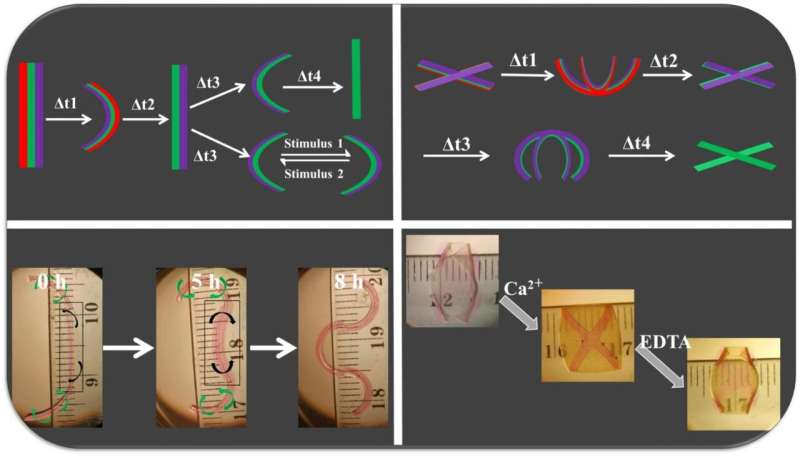4-D bioengineering materials bend, curve like natural tissue

Tissue engineering has long-depended on geometrically static scaffolds seeded with cells in the lab to create new tissues and even organs. The scaffolding material—usually a biodegradable polymer structure—is supplied with cells and the cells, if supplied with the right nutrients, then develop into tissue as the underlying scaffold biodegrades. But this model ignores the extraordinarily dynamic morphological processes that underlie the natural development of tissues.
Now, researchers at the University of Illinois Chicago have developed new 4-D hydrogels—3-D materials that have the ability to change shape over time in response to stimuli—that can morph multiple times in a preprogrammed or on-demand manner in response to external trigger signals.
In a new Advanced Science study, the UIC researchers, led by Eben Alsberg, show that these new materials may be used to help develop tissues that more closely resemble their natural counterparts, which are subject to forces that drive movement during their formation.
"The hydrogels can be programmed or induced to undergo multiple controllable shape changes over time. This strategy creates experimental conditions to partially mimic or stimulate the continuous different shape changes that developing or healing tissues undergo, and it may let us study morphogenesis and also help us engineer tissue architectures that more closely resemble native tissues," said Alsberg, the Richard and Loan Hill Professor of Biomedical Engineering and corresponding author on the paper.
The novel material is made up of different hydrogels that swell or shrink at different rates and extents in response to water or the concentration of calcium. By creating complex layering patterns, the researchers can guide the conglomerate material to bend one way or another as the layers swell and/or shrink.
"We can change the shape of these materials by adjusting, for example, the amount of calcium present," said Alsberg, who also is professor of orthopedics, pharmacology and mechanical and industrial engineering at UIC.
In their experiments, the researchers were able to cause the hydrogel to form into pockets similar in shape to alveoli, the tiny sac-like structures in the lung where gas exchange takes place.
Not only are Alsberg's hydrogels able to change their architecture multiple times, but they also are highly cytocompatible, which means they can have incorporated cells and the cells remain alive—something that many existing 4-D materials are unable to do.
"We are really looking forward to pushing the limits of what our unique hydrogel systems can do in terms of tissue engineering," said Aixiang Ding, postdoctoral research associate at UIC and co-first author on the paper. UIC's Oju Jeon, research professor, is also a co-first author.
More information: Aixiang Ding et al, Cell‐Laden Multiple‐Step and Reversible 4D Hydrogel Actuators to Mimic Dynamic Tissue Morphogenesis, Advanced Science (2021). DOI: 10.1002/advs.202004616
Provided by University of Illinois at Chicago





















